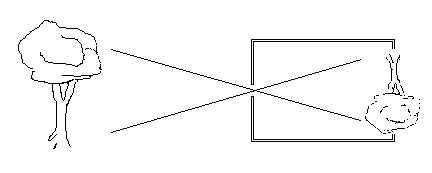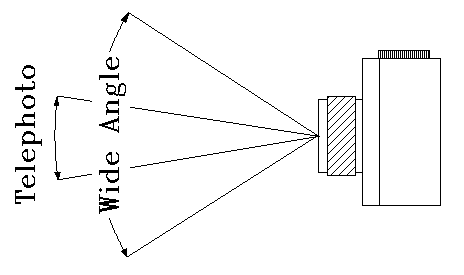The First Camera - The Pinhole
The first cameras had no film and no lens, and you certainly couldn't carry them around!
The word "camera" is Italian. It means "room", and that's how big those first cameras were: to use them you had to climb inside. Imagine a room at the top of a tall building. Inside there is no furniture, just a white wall and, opposite it, a window with close-fitting wooden shutters. There is a small hole in one of the shutters and, when the shutters are closed, this hole is the only place where light can get in. It would have been fairly dark - "camera obscura" means "darkened room".

Now imagine that there is a tall tree outside the window. Light from the top of the tree enters through the hole and, because light always travels in straight lines, hits the wall at the bottom. Meanwhile, light from the bottom of the tree enters through the same hole and hits the wall at the top. Light from each part of the tree is projected onto the white wall by the pinhole creating a detailed, upside down picture of the tree. There was no film in these early camera obscuras, so if you wanted a copy of the picture, you had to stick a piece of paper onto the wall and draw round it.
Now, to get a sharp image with a pinhole camera you have to have a small pinhole. If the hole is large, the light can spread out and you get a blurred picture. Unfortunately, however, A small hole means that not much light can get in and the picture is rather dark.
This is where lenses come in.
What a lens does is to provide a large opening for the light to enter. Then, instead of allowing the light to spread out to produce a blurred image, the lens focuses the light to produce a sharp picture. So, replace the pinhole with a lens and you can have a larger hole, more light can get in and the picture is brighter.
Modern Cameras
All modern cameras have the same form as the old camera obscura. Yes, they are smaller, but at their heart is a dark space with a lens to collect light and to focus it. Instead of having to pinning a sheet of paper to the wall and drawing round the picture, we have film.
Most of the controls on a modern camera are a consequence of that last item: the film. In order to produce a picture the film needs just the right amount of light - not too much and not too little. All the paraphernalia of apertures, shutter speeds and exposures are concerned with making sure that just the right amount of light gets to the film.
Later articles in this series will be concerned with how to get the exposure right. For the rest of this article I want to look at the types of camera and lens which you will come up against in the photographic world today.
Compact and SLR
There are all sorts of variations on the theme of a dark space with a lens at one end and film at the other. As far as the amateur photographer is concerned, however, there are really only two types of camera widely used today; the compact and the SLR (single lens reflex). Compact cameras are small and extensively automated. They are very good at what most people want - well exposed memories of birthdays, holidays and weddings. It is a superbly designed tool for a particular photographic job. If I had been writing this article ten years ago I would have referred to the "rangefinder camera" rather than the compact. This is the ancestor of the modern compact and includes classic cameras such as the Leica 'M' series. In both cases when you take a picture you don't look through the lens, but past it. Normally this is not a problem. Imagine, however that you are trying to photograph something very small: an insect perhaps. You can see the insect through the viewfinder, but is it in front of the lens?
This is where the strengths of the SLR appear. The SLR has a complex system of prisms and mirrors which allows you to look straight through the lens - to see what the film will see when you press the shutter. The problem with this, of course, is that when you decide to take a picture, the mirrors have to get out of the way. The result is a camera which is larger, heavier and noisier. It has other advantages, however.
An SLR comes with all sorts of options. At the very least the lens can be removed and in extreme cases it may be possible treat the camera as a kit of parts from which to construct the tool for any particular job.
Types of Lens
You don't have to be involved in photography very long before you hear words such as "telephoto", "standard lens" and "wide angle". These different types of lens offer different views of the subject.
So called "standard lenses" give a view similar to that with the unaided eye.
"Telephoto" lenses are, in effect, small telescopes; they make distant objects seem closer. Don't fall into the trap of assuming that the picture you get with a telephoto will be the same as the one you would get with a standard lens if you just walked a bit closer; it won't be! I'll go into this in a bit more detail in a later article. Telephoto lenses are used for nature photography when you can't get close to the bird or animal which you want to photograph. They are also used in sport when you are stuck on the touch line, far from the action.

"Wide angle" lenses are so called because their angle of view is wider; they include more in the picture. This can be useful in cramped spaces.
Lenses of these different types are distinguished by a number called the "focal length". Don't worry about what this number actually means, just treat it as something which helps to distinguish between different kinds of lens.
With a 35mm camera, the focal length of a standard lens is about 50mm. Telephoto lenses have focal lengths greater than this. A telephoto lens with a focal length of about 100mm is good for portraiture while lenses of 300mm or more are required for photographing birds.
Wide angle lenses have shorter focal lengths than the standard. A typical wide angle lens has a focal length of 28mm or 35mm. When you go to very short focal lengths the image can appear extremely distorted. The so called "fish eye" lens has a focal length of 15mm or even less. At these focal lengths so much is included in the picture that if you point the camera forwards you are in danger of including your shoes!
"Zoom lenses" are lenses whose focal length can be changed. A common zoom lens is the 80mm-200mm lens which can take up any required focal length between these limits.
top of page